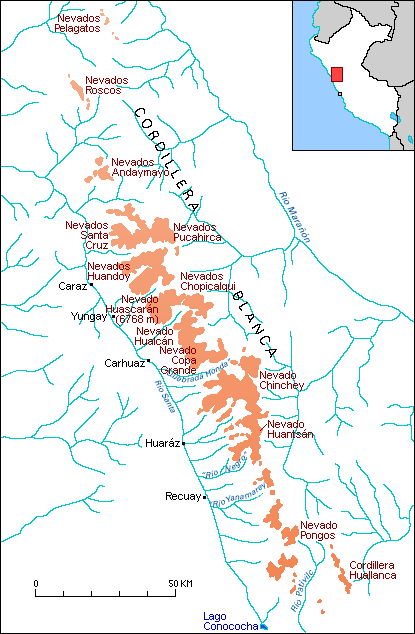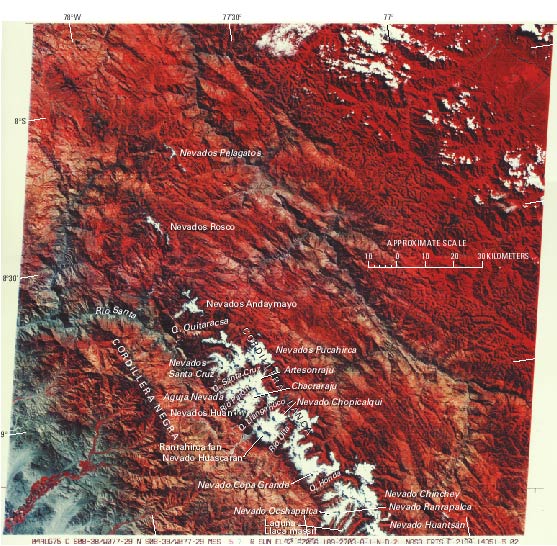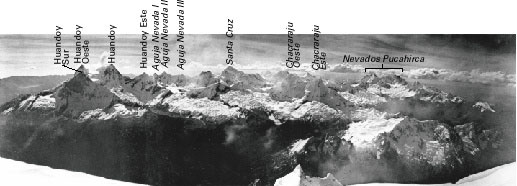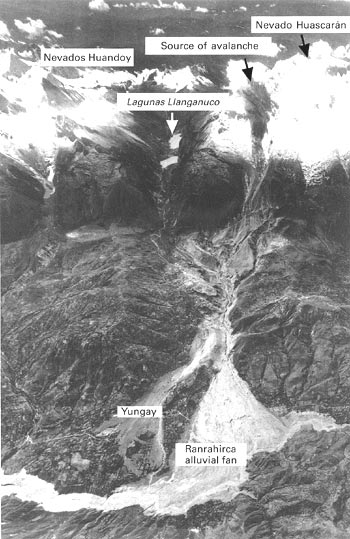Cordillera Blanca
La Cordillera Blanca es la cadena montañosa tropical cubierta de hielo más extensa del mundo y tiene la mayor concentración de hielo en Perú. Es parte de la Cordillera Occidental y se extiende en dirección noroeste por unos 200 km entre las latitudes 8°08' y 9°58'S y las longitudes 77°00' y 77°52'O. Marca la divisoria continental; el Río Santa, al oeste, drena hacia el Océano Pacífico, mientras que el Río Marañón, al este, drena hacia el Océano Atlántico. La Cordillera Blanca cuenta con cinco de los picos más espectaculares de más de 6,000 m en Los Andes peruanos. El pico más alto (Nevado Huascarán) alcanza una altitud de 6,768 m sobre el nivel del mar. Se reconocen un total de 722 glaciares individuales en la Cordillera Blanca, que cubren un área de 723.4 km². La mayoría de estos glaciares se encuentran en el lado occidental de la cordillera, donde 530 glaciares cubren un área de 507.5 km². En el lado oriental hay 192 glaciares que cubren un área de 215.9 km²; el término glaciar más bajo está a 4,200 m sobre el nivel del mar. La mayoría de los glaciares, el 91 % del total, están clasificados como glaciares de montaña; son generalmente cortos y tienen pendientes extremadamente empinadas. El resto se clasifica como glaciares de valle, excepto por un casquete de hielo. Cuatro son similares a glaciares de roca.

Cordillera Blanca en Imágenes Landsat
La siguiente figura, la mejor imagen disponible de Landsat 1, 2 o 3 del área de la Cordillera Blanca, proporciona una excelente visión pictórica general de las principales áreas glaciadas. Al norte del segmento principal glaciado de la Cordillera Blanca se puede observar la cobertura de hielo en los Nevados Pelagatos y los Nevados Rosco. La gran curva del valle del Río Santa (en el centro izquierdo de la imagen) marca en gran parte el extremo norte de la Cordillera Blanca. La fisiografía general del área está dominada por este profundo valle, así como por las Cordilleras Negra y Blanca, al oeste y este, respectivamente. Es posible identificar las áreas glaciadas separadas en los Nevados Andaymayo en la parte noroeste de la Cordillera Blanca.

Dos afluentes del Río Santa, la Quebrada Quitaracsa y la Quebrada Santa Cruz, delimitan el complejo sistema glaciar de los Nevados Pucahirca y los Nevados Santa Cruz. El valle de la Quebrada Santa Cruz y la Quebrada Llanganuco al sur delimitan otro sistema glaciar, dispuesto en forma de herradura alrededor del Río Parón. Dentro de esta área se encuentran los picos montañosos Aguja Nevada, Artesonraju, Chacraraju y los Nevados Huandoy. Estos picos pueden verse en la vista panorámica mostrada en la siguiente figura. La Quebrada Llanganuco y el Río Ulta delimitan el macizo del Huascarán. El collado entre los picos norte y sur del Nevado Huascarán puede verse en la figura anterior; son particularmente conspicuas las cicatrices de la catastrófica avalancha de escombros de Huascarán de mayo de 1970 que se originó en el lado oeste del pico norte y destruyó por completo la ciudad de Yungay (ver la figura siguiente).


Entre el Río Ulta al norte y la Quebrada Honda al sur, un gran área glaciada culmina en el Nevado Copa Grande (6,188 m). Un gran y continuo área glaciada se extiende desde la Quebrada Honda hacia el sur hasta aproximadamente el Río Negro, pero solo los dos tercios del norte están representados en la imagen Landsat. Esta extensa área glaciada incluye los Nevados Ocshapalca y Ranrapalca y el macizo montañoso de la Laguna Llaca. La parte sur de esta región glaciada y otras tres áreas glaciadas en la parte sur de la Cordillera Blanca están cubiertas por otra imagen Landsat más al sur.



